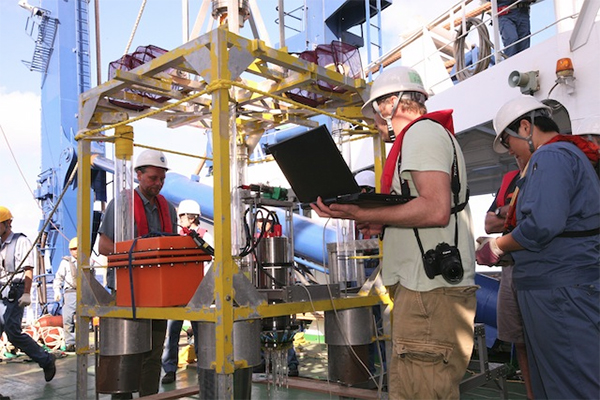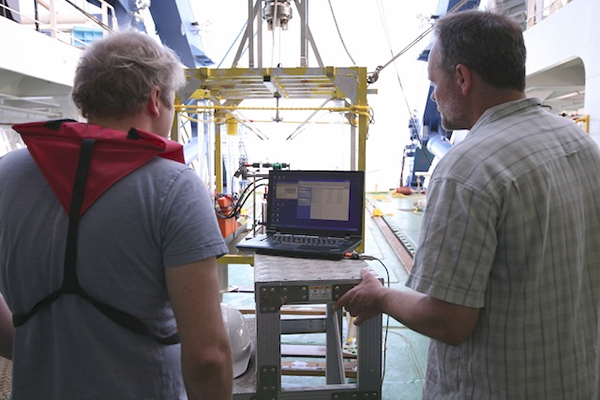QUELLEレポート
深い海溝域にいるバクテリアの重要性
The importance of bacteria in deep trenches
2013/10/10
Ronnie N. Glud(University of Southern Denmark)
(今回は昨日紹介しました「ランダー」を使用して研究しているデンマークのRonnie N. Glud教授に、今回の調査について書いていただきました。海溝にいるバクテリアの重要性について書かれています。少し難しいかもしれませんが、ぜひお読みください!英語の勉強にもなります。なお、ページ下の方には日本語訳を付記しましたので、「英語苦手だよ〜」という方はそちらをご覧ください。)
Background and research idea
In surface waters, photosynthetic active algae produce O2 and fix CO2 into organic material. This organic material form the basis for the foodwebs of the oceans and most is turned over in the upper zone of the Ocean. However, ultimately a fraction of the organic material reaches the sea-bed, where it serves as a food source for the organisms living here. In coastal waters about 50% of the material reaches the sea-bed, while the fraction in deeper waters is much less. The material can settle as algae aggregates, fecal pellets or carcasses. Most of the material is turned over by bacteria that consume O2 and release CO2. But a fraction of the material is never turned over and stored in the seabed in different forms (fossil fuel is one such form). On geological time-scales the balance between organic material turned over by bacteria versus the amount stored in the sea-bed ultimately determines the O2 and CO2 levels of the oceans and the atmosphere. In short, the efficiency by which bacteria consume organic material in the seabed is the single most important process regulating O2 level on Earth and thereby the conditions for redox chemistry and life on the planet. Therefore we are very interested in understanding how efficient bacteria degrade organic material in the sea-bed.
While many have studied conditions in coastal and shelf waters, fewer have been done so in the deep sea and only a handful have been carried out in deep trenches. We believe that trenches represent areas of intensified deposition of organic material and that they may represent hot-spots of retention and turn-over of organic material mediated by bacteria specially adapted to operate at the harsh conditions of the trenches - most notably the extreme hydrostatic pressure.
Research strategy and methods
Sediment recovered from great depth undergoes changes in hydrostatic pressure and temperature and this affect the chemistry and microbial activity of the samples. Reliable measurements of the metabolic activity of bacteria therefore have to be realized directly at the seabed. Therefore we have constructed specialized instruments "landers", which autonomously can go down to the sea-bed and measure the microscale O2 distribution in surface sediments. From such data we can calculate the metabolic activity of bacteria in the sediment (i.e how much organic material are they consuming). The measurements are conducted by 8 small microelectrodes that are fixed to a cylinder that insert the sensors into the sediment in very small steps- after measuring one set of profiles the sensors are retracted, and the cylinder is moved 8-10 cm horizontally and a new set of profiles can be measured. At the end of the deployment, 200 kg of ballast is released and the lander slowly ascends to the surface where it is taken onboard the ship. Here we the download the data and begin the calculations.
These in situ measurements are complemented by measurements in sediment recovered by other instrumentation. Here we measure chemical and physical characteristics of the sediment (for instance how much organic material the sediment contain). From natural radionuclide we also quantify how old the sediment is and how much material that is reaching the bottom of the trench. Furthermore, we also quantify the number of bacteria and virus in the sediment and try to identify the most important bacteria.
Aim
We will quantify the amount of organic material reaching the trench environment and how much of this that is turned-over by bacteria. Ultimately we would like to get an understanding of how important trenches are for the carbon budget in the deep-sea (and globally). Additionally we will try to characterize the bacteria responsible for this activity - Who are they? How similar are they to bacteria in more well-studied areas? And do they differ in different trenches?
研究の背景
海洋の表層では、光合成を行う藻類が酸素を生成し、二酸化炭素を有機物として固定します。この有機物は海洋における食物網の基盤をなしており、植物プランクトンが動物プランクトンに、動物プランクトンは小魚に、小魚はより大きな魚へと食べられます。この食物網の多くの部分は海洋表層で循環しますが、一部の有機物は海底に到達し、そこに生息する底生生物の栄養となります。沿岸域ではだいたい50%の有機物が海底に届きますが、深くなるにつれ、その割合は少なくなっていきます。有機物は植物プランクトンのかたまり(アグリゲートといいます)や、動物のフン、死骸などの形で海底へ重力によってゆっくりと沈降します。このようにして運ばれた有機物のほとんどはバクテリアによって消費され、海底にある酸素を消費し二酸化炭素を放出します。しかし、ほんのごく一部の有機物はより分解されにくい有機物に変化し、利用されることなく海底に蓄積されていきます(例えば化石燃料)。
これを地質学的タイムスケールで概観すると、バクテリアによる有機物消費量と、海底に蓄積される量の差し引きが、海洋及び大気中における、酸素と二酸化炭素の割合を決定しています。言い換えれば、海底にいるバクテリアの有機物の消費効率は、地球上の酸素レベルを調整し、この惑星の生命と酸化還元状態を決定する最も重要なプロセスであると考えています。だからこそ、私たちは海底でバクテリアによる有機物の消費効率がどれくらいなのかに大変興味を持って研究しているのです。
今まで沿岸域や大陸棚ではたくさん調査されてきましたが、深海での調査は少なく、海溝での調査ともなると数えるほどしかありません。海溝は多くの有機物が沈積していることから、超高圧に代表される過酷な海溝環境に適応しているバクテリアによる有機物サイクルのホットスポットではないか、と私たちは考えています。
研究戦略と調査方法
大深度から通常の方法で採取した堆積物は、水圧や水温の変化によって、サンプルの化学特性や微生物活動などに影響を与えてしまいます。そのため、信頼性の高いバクテリア活性を測定するためには、海底で現場測定を実施する必要があります。そこで私たちは特別製の「ランダー」装置を自ら開発しました。この「ランダー」は自律的に海底に到達し、堆積物表面からマイクロメータースケールで、深さごとの酸素濃度を測定できます。このデータから、私たちは堆積物内のバクテリアによる有機物の消費速度などの代謝活動を計算します。
この測定はランダーの心臓部である円筒形の耐圧容器の下部に設置された8つの微小なガラスセンサーで行います。海底に到着した後、ランダーに組み込まれている昇降装置を使って、耐圧容器をマイクロメーター単位で少しずつ下に降ろしていきます。耐圧容器の下降に伴ってガラスセンサーは堆積物に突き刺さり、堆積物表面から内部にかけての溶存酸素の分布を測定します。耐圧容器は1回のデータを取り終わると、初期位置まで上昇した後、水平方向に8〜10cm移動し、新たな場所で測定を行います。すべての測定が終了すると、200kgのバラスト(錘)を離し、「ランダー」がゆっくりと表層にあがってきたところで、船で回収します。船に「ランダー」をあげたら、記録していたデータをダウンロードし分析結果を計算します。
このような「ランダー」を用いた現場測定だけではわからないことがあるので、「しんかい6500」などで海底から採取された堆積物の分析を行い、データを補完します。堆積物の有機物量など、物理化学的な特性を測定するとともに、自然の放射性核種の分析などを併用し、堆積速度を計算することで、堆積物の古さや、どのくらいの有機物が海溝に届いたのか定量化します。さらに、堆積物内のバクテリアやウィルスの数を調べ、最も重要なバクテリアの同定を試みます。

写真1:「ランダー」を海底へ沈める前に、入念なチェックをするGlud教授(奥)とWenzhoefer博士(手前)
目標
海溝の環境下において、どのくらいの有機物が届くのか、またそれがどのくらいのバクテリアによって循環しているのかを定量化したいと考えています。特に私たちは深海および全地球上における炭素量の収支を議論する上での、海溝の重要性を明らかにしたいと思っています。さらに、このトンガ海溝にいるバクテリアの特徴は何なのか?他の調査された場所にいるバクテリアとどのくらい同じなのか?そして他の海溝にいるバクテリアとどう違うのか?ということを明らかにしたいと考えています。

写真2:記録されたデータをPCにダウンロード中。約11時間も海底で記録していたので時間がかかります。